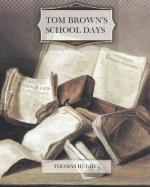Now in the study that night Tom was the upholder of the traditionary method of vulgus doing. He carefully produced two large vulgus-books, and began diving into them, and picking out a line here, and an ending there (tags, as they were vulgarly called), till he had gotten all that he thought he could make fit. He then proceeded to patch his tags together with the help of his Gradus, producing an incongruous and feeble result of eight elegiac lines, the minimum quantity for his form, and finishing up with two highly moral lines extra, making ten in all, which he cribbed entire from one of his books, beginning “O genus humanum,” and which he himself must have used a dozen times before, whenever an unfortunate or wicked hero, of whatever nation or language under the sun, was the subject. Indeed he began to have great doubts whether the master wouldn’t remember them, and so only throw them in as extra lines, because in any case they would call off attention from the other tags, and if detected, being extra lines, he wouldn’t be sent back to do more in their place, while if they passed muster again he would get marks for them.
The second method, pursued by Martin, may be called the dogged or prosaic method. He, no more than Tom, took any pleasure in the task, but having no old vulgus-books of his own, or any one’s else, could not follow the traditionary method, for which too, as Tom remarked, he hadn’t the genius. Martin then proceeded to write down eight lines in English, of the most matter-of-fact kind, the first that came into his head; and to convert these, line by line, by main force of Gradus and dictionary into Latin that would scan. This was all he cared for—to produce eight lines with no false quantities or concords: whether the words were apt, or what the sense was, mattered nothing; and as the article was all new, not a line beyond the minimum did the followers of the dogged method ever produce.
The third, or artistic method, was Arthur’s. He considered first what point in the character or event which was the subject could most neatly be brought out within the limits of a vulgus, trying always to get his idea into the eight lines, but not binding himself to ten or even twelve lines if he couldn’t do this. He then set to work as much as possible without Gradus or other help, to clothe his idea in appropriate Latin or Greek, and would not be satisfied till he had polished it well up with the aptest and most poetic words and phrases he could get at.




